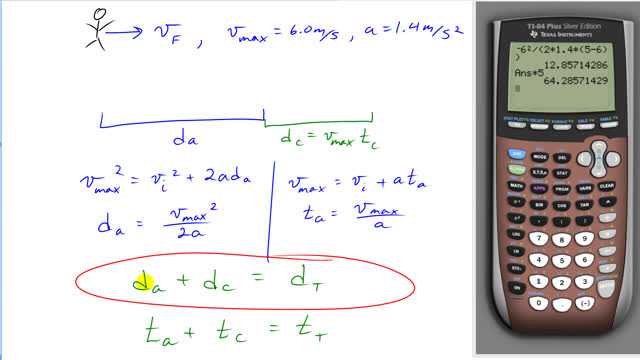
A fugitive tries to hop on a freight train traveling at a constant speed of 5.0 m/s. Just as an empty box car passes him, the fugitive starts from rest and accelerates at to his maximum speed of 6.0 m/s, which he then maintains.
- How long does it take him to catch up to the empty box car?
- What is the distance traveled to reach the box car?

In order to watch this solution you need to have a subscription.
This is Giancoli Answers with Mr. Dychko. This fugitive and this train will eventually cover the same distance by the time the fugitive catches up and that's what I'm saying algebraically here; distance of the fugitive while he's accelerating plus the distance that he covers at constant speed— c for constant— equals the distance covered by the train. Now we can figure some things out about this path of the fugitive and he has this segment of time when he's accelerating and the distance he covers there is given by this formula and initial speed is zero and then divide both sides by 2a. We get the distance covered while accelerating is his maximum speed squared over 2 times his acceleration. And then we'll figure out the time that he spends accelerating by knowing that v max equals v initial plus at and initial speed again is zero and then divide both sides by a and we get that the time spent accelerating is v max over a and this will be useful down here where we say that the total distance covered by the fugitive is the same as the distance covered by the train and the time the fugitive spends moving is the same as the time as the train spends moving. And now we'll do a whole bunch of substitutions. So we have that d a is v max over 2a so I just made that substitution there and then d c is the distance covered at constant speed which is his maximum speed times whatever amount of time he spends going at constant speed and then the distance covered by the train is the train speed multiplied by the time that this train spends traveling. And down here substituting for t c, by rearranging this formula a bit by moving this t a over to the right side or subtracting it from both sides, we get that t c is a t of the train minus the time spent accelerating. And then we can substitute for the time spent accelerating because we figured that out up here; it's v max over a and now it's a bunch of algebra work to get the final answer. So we have negative v max multiplying into the brackets there and then take this v max squared over a subtract it from both sides and then it becomes minus v max squared over 2a on the right-hand side you can multiply this by 2 over 2 and then it has a common denominator and it's gonna be subtracted from both sides and then factor out the time of the train from these two terms and then divide both sides by this bracket here. And then you are left with this for the total time or the time that this train spends traveling. And we have a maximum speed of 6 meters per second and we square that, divide by 2 times the acceleration of 1.4 meters per second squared multiplied by the velocity of the train— 5 meters per second—minus the maximum velocity of the fugitive— 6 meters per second— and we get a total of 13 seconds between when the train passes and when the fugitive catches up to it with two significant figures. And then total distance covered is the distance covered by the train say and it's going at 5 meters per second for this amount of time and that's 64 meters.
why is there Vmax? Can we just write normal V
Hi suriyak786, yes, you could write instead of , just so long as there's an understanding of what (or is: it's the speed the car reaches after the period of acceleration.
All the best,
Mr. Dychko